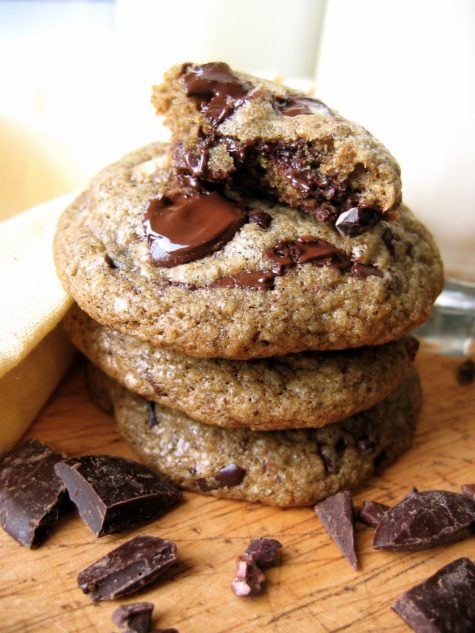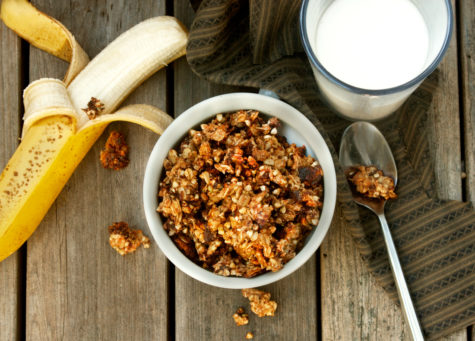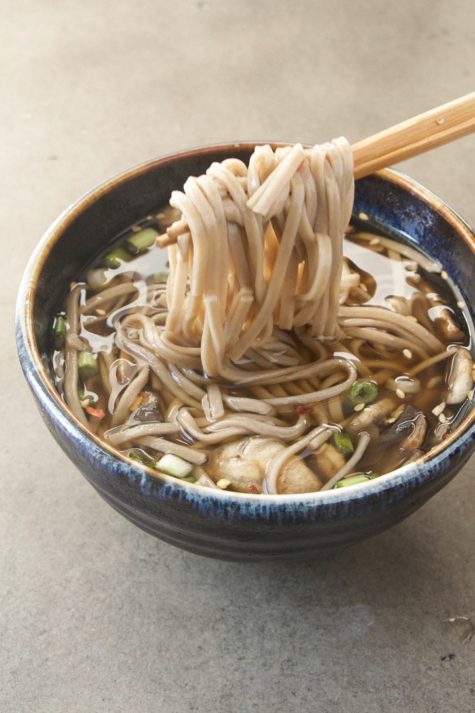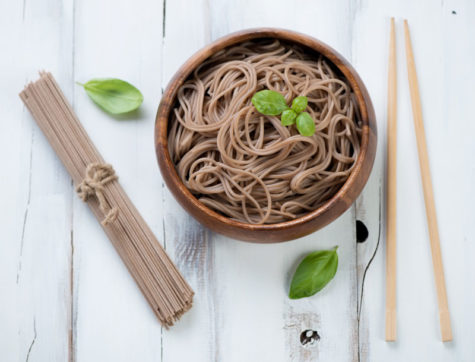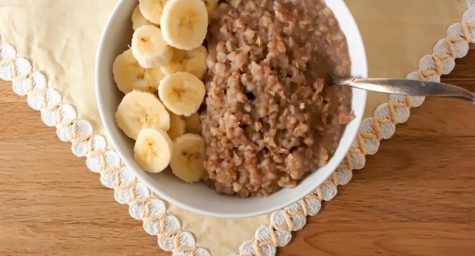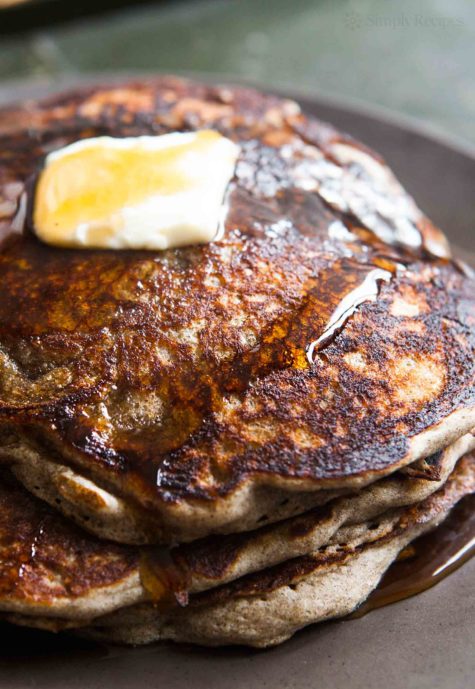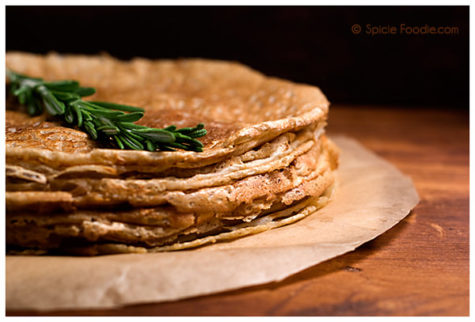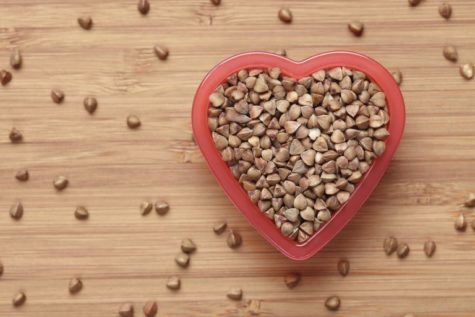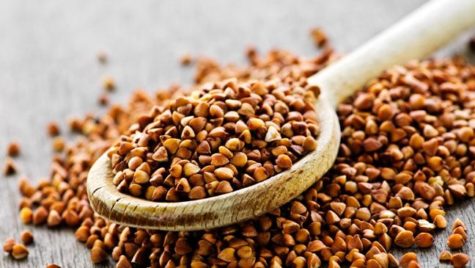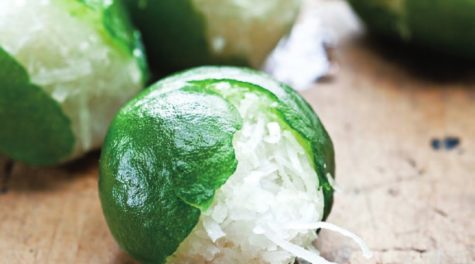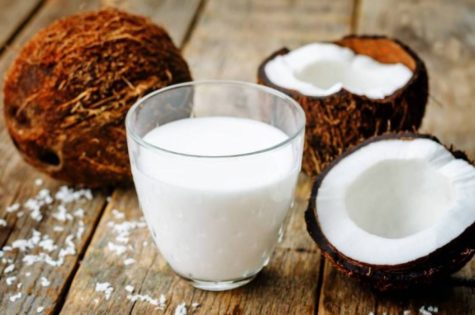Monthly Archives: June 2018
Buckwheat Chocolate Chip Cookies
- ⅓ cup unsalted butter, softened
- ½ cup white sugar
- ⅓ cup brown sugar
- 1 egg
- 2 tbsp vanilla extract
- 3 cups buckwheat flour
- 1 teaspoon salt
- ⅓ teaspoon baking powder
- ½ teaspoon cornstarch
- 1 teaspoon honey
- 2 cups semi-sweet chocolate chips
Preheat oven to 350. Beat together sugars with butter until smooth. Add in egg, vanilla, and honey, beating well. Combine dry ingredients, including chocolate chips, in a large bowl and cover with wet ingredient mixture. Form 2-inch balls of dough and create rows on baking sheet lined with parchment paper. Bake for 10 minutes or until slightly brown.
From: Jen Reviews
Buckwheat Granola with Vanilla
- 3 cups roasted buckwheat groats
- 1 cup quinoa
- ½ cup uncooked millet
- ½ teaspoon sugar
- 1 cup chopped walnuts
- 1 cup sesame seeds
- 1 cup sunflower seeds
- ⅓ cup unsweetened applesauce
- 4 tablespoons olive oil
- 2 tablespoons honey
- 1 teaspoon vanilla extract
- 1 teaspoon maple syrup
Preheat oven to 360. Combine groats, millet, walnuts, and seeds in a large bowl.
In a small pot, on low heat, warm sugar, vanilla extract, maple syrup, honey, applesauce and olive oil. Pour wet mixture over ingredients in large bowl until well covered. Spread onto baking sheet lined with parchment paper. Bake for 25 minutes or until quinoa seeds appear golden. Cool before serving or storing.
From: Jen Reviews
Spicy Buckwheat Soup
- 8 oz buckwheat noodles
- 12 oz pork tenderloin
- 4 cups chicken stock
- 2 tablespoons salt
- 2 teaspoons Szechuan peppercorns
- 3 dried red chili pods
- ½ teaspoon red pepper flakes
- 1 cup mushrooms
- 1 tablespoon soy sauce
De-seed and julienne chili pods. Boil noodles. Heat oil in a skillet and sear salted/peppered pork on all sides for about 10 minutes. Drain noodles. Heat chicken stock over medium heat, adding noodles, peppers, pepper flakes, mushrooms, and soy sauce. Simmer. Add thinly sliced pork to broth and serve.
Source: Jen Reviews
Curry & Coconut Soba Noodles
Ingredients:
- 8 oz buckwheat soba noodles
- ½ cup fresh basil, chopped
- ½ cup toasted pepitas (pumpkin seeds)
- 1 cup almond butter
- 2 tablespoons green curry paste
- 1 cup coconut milk
- 2 tablespoons tamari
Boil noodles and drain. Whisk together curry paste, coconut milk, tamari, and almond butter. Add mixture to noodles and stir. Transfer pasta to bowls and top with fresh basil and pepitas for serving.
From: Jen Reviews
Buckwheat Porridge
- 3 cups raw buckwheat groats
- 1 ½ cups almond milk
- ½ cup maple syrup
- ⅓ cup honey
- 1 ½ teaspoons cinnamon
- ½ cup shredded unsweetened coconut
- 1 ½ teaspoons vanilla extract
- 2 tablespoons ground flax meal
- Dash of sea salt
Soak groats overnight. Process groats alone and pulse a few times to break down texture. Add flax, salt, vanilla, cinnamon, honey, milk, and syrup and process until smooth. Add coconut last. Divide into bowls and top with sliced fruit of your choice, such as strawberries, bananas, or apples sprinkled with more cinnamon!
Found at: Jen Reviews
Bacon Brown Sugar Buckwheat Pancakes
- 1 cup all purpose-flour
- 1 ½ cups buckwheat flour
- ½ cup brown sugar
- 1 teaspoon baking soda
- 1 teaspoon vanilla extract
- 2 eggs
- ½ teaspoon salt
- 3 strips bacon
- 1/3 cup bacon grease
- 2 cups buttermilk
Cook and dice bacon strips and set aside. In a large bowl, mix both flours, sugar, salt, and baking soda. In a separate bowl, combine eggs, vanilla extract, bacon grease, and buttermilk in a whisking fashion. Add bacon and buttermilk mixture to dry ingredients. Warm greased skillet over medium-high heat. Pour about 1/3 cup of batter in, cooking each side for about 4 minutes or until the pancakes are browned. Serve with maple syrup.
From: Jen Reviews
Buckwheat Crepes
- 1 cup of raw buckwheat groats
- About 4 cups of water
- ½ teaspoon salt
- ½ teaspoon ground cinnamon
- 1 egg
- 1 tablespoon honey
- 3 tablespoons brown sugar
Combine groats with 2 cups of water and soak them overnight. Be sure to drain them at least twice throughout this process. Drain one more final time and then blend groats with brown sugar, salt, cinnamon, honey, remaining water, and egg until smooth. Pour about ½ cup of batter into a lightly greased skillet over medium heat, evenly covering its surface. Cook for about 2 minutes on each side until firm in the center. Serve by adding honey, syrup, chocolate syrup, confectioner’s sugar, or anything else you may prefer on top!
From: Jen Reviews
More About Buckwheat
Here’s a great little article about Buckwheat from Jen Reviews. Buckwheat has often had a dull reputation associated with it, particularly because its flavor is somewhat lacking and it is a healthier option that requires more effort when being prepared. It is also not as readily available as other harmful, fatty snacks and meals may be.
As we strive to eat more nutritiously, and as we uncover seemingly increasing harmful effects of processed flours and grains, it’s good to know that nutty, wholesome, healthy, grain-like alternatives such as buckwheat exist.
Below is a list of the top 14 benefits of buckwheat:
Buckwheat is Not a Grain
Nutritionally, grains are unnecessary and can even be deemed as harmful, particularly because they can damage the digestive tract, are high in caloric content, and reduce the absorption of calcium.
As a result, avoiding grains is a popular dietary option. Fortunately, buckwheat, often mistakenly listed as a grain, is actually a pseudocereal– or fruit seed– that comes from the Polygonaceae family. Consumed in either flour or its pure form, buckwheat is most closely associated with other pseudocereals, such as quinoa.
Pseudocereals are not grasses, while true cereals are. Pseudocereals are plants that product suides or fruits that are consumed, prepared, and used as grains. They are usually very high in protein and other essential nutrients. They are also naturally gluten-free.
Therefore, buckwheat is not quite an actual cereal, but its nutritional values and usage diversity makes it comparable to not only cereals, but grains, millet, rice, and barley as well.
As a result, it can often be treated, cooked, and prepared in similar manners. It can typically be factored into recipes that call for these comparable ingredients.
The grain-like way that it is soaked– often for long periods of time or overnight– and cooked can undoubtedly be deceiving, leading some to believe that it is a grain.
Believe it or not, it’s actually not a form of wheat either. The portion of buckwheat that is edible derives from a plant related to rhubarb and sorrel.
It is, indeed, a seed.
Bottom Line: Buckwheat is a seed, not a grain or a wheat. If anything, you should go out of your way to consume it for its benefits, rather than mistakenly avoid it!
Buckwheat is Chemical-Free
On its own, buckwheat grows efficiently and quickly. A likely contributor as to why it is a popular global crop, harvest occurs just 10-12 weeks after plantation.
As a result, it does not require the same attention, pesticides, and maintenance that other seeds may in order to enhance growth, leaving the seed clean of potentially harmful additives.
Pesticides, though used to deter pests from the growth of crops, have also been known to kill innocent, beneficial insects, fish, birds, and other plants. Limiting the use of pesticides is not only favorable for the ultimate consumer of the crop, but for the environment and flourishment of other beings, plants, and crops as well.
Additionally, while buckwheat flowers have been known to keep the honeybee population flourishing with their morning nectar, they also support the existence of smaller insects, particularly hoverflies.
The buckwheat crop itself keeps pests that are attracted to other crops at bay, ensuring that potatoes, broccoli, and other vegetable crops remain untouched. Buckwheat simply needs to be grown within 20 feet of said crops in order to be effective.
Groats, the correct term for buckwheat “grains” or buckwheat hulled seeds, are reliable, successful crops that can endure both cool and dry climates, acidic soils, and unpredictable weather. Over time and particularly in Tibet, buckwheat has even been known to grow at altitudes higher than other cultured plants. Late spring and summer crops will grow taller than those planted any later.
Although it technically grows best in warmer weather, buckwheat’s durability has contributed to its common plantation across cooler climates in the United States, Russia, and China.
As a bonus, it can also be used as a cover crop to reduce weeds. Buckwheat seeds can be purchased by most companies that sell cover crop seeds, but farm supply and health food shops also provide a decent selection.
Bottom Line: Buckwheat is packed with nutrients, not chemicals, and it reduces the need for harmful pesticides.
Buckwheat is a Great Source of Fiber
Buckwheat seeds, also known as “groats,” are full of dietary fiber, both soluble and insoluble. Insoluble fiber, unlike soluble fiber, does not dissolve in water. Soluble fiber is found not only in buckwheat, but also in oats, barley, beans, and lentils. Insoluble fiber can be found in nuts, seeds, and other whole-wheat foods.
Foods rich in dietary fiber protect us from various cancer diagnoses– including cancers of the esophagus, rectum, colon, stomach, and mouth– among other diseases.
Adding fiber to your diet also helps you feel full, increases the density of stools, dilutes harmful substances, and expedites their elimination from the body. The high fiber content in buckwheat is said to lower blood sugar levels following meals.
Bowel movements are more frequent as increased fiber intake prevents constipation and helps create a clear tract.
Just one cup of buckwheat contains 17 grams of fiber, closely amounting to the 25-30 grams recommended per day. As a result, groats are commonly categorized as “superfoods.”
Its high content of fiber eliminates the need to otherwise ingest other high-fiber fruits and vegetables. In fact, five servings of vegetables and fruits plus three servings of whole grains would have to be ingested to reach the 30-gram-per-day fiber recommendation.
Ironically, buckwheat is also used to treat diarrhea. However, buckwheat should be avoided by overly sensitive individuals, such as those with IBS (irritable bowel syndrome) or Crohn’s disease. The seed can either help or exacerbate symptoms and could cause gas and cramping.
One should also be careful to slowly but surely increase one’s intake of fiber, and therefore buckwheat, as too much too quickly can surely result in abdominal discomfort. However, drinking plenty of water is a perfectly acceptable motion to eliminate such.
Bottom Line: Buckwheat is abundant with fiber.
Buckwheat is Gluten-Free
Despite its misleading name and as noted previously, buckwheat is not actually a wheat, nor a grass. Since it’s naturally gluten-free, buckwheat is a perfectly acceptable alternative to barley, oats, rye, and wheat, thus making it preferred to those who are allergic to any of these elements.
Gluten has been deemed harmful for numerous reasons and it has recently been purposely avoided whenever possible as a result. It has been shown to cause asthma, vitamin B12 deficiency, excessive weight gain or loss, and it has been directly linked to the causes of up to 200 other medical conditions.
Gluten is also commonly a cause of dizziness, thyroid disease, skin disease, loss of balance, neuropathy, and nerve pain. It has been linked to the development of certain skin diseases.
It can also trigger testosterone issues in men, migraines, and liver damage. Gluten can also cause inflammation of the gut, otherwise known as “leaky gut,” leading to intestinal permeability.
This is significantly harmful because intestinal permeability disrupts the gut’s natural ability to filter out harmful items that we ingest on a daily basis, such as dust, viruses, and bacteria. If the gut fails to filter these items through the intestinal tract and out the other end of the body, they will be absorbed into the bloodstream.
The damage gluten can do to the body does not stop in the gut. Believe it or not, gluten can also affect the functionality of your brain. As a direct result of the gut inflammation and other microbiome disturbances caused by gluten consumption, your vulnerability to brain-related diseases such as dementia and Alzheimer’s disease is significantly increased.
If only for the sake of avoiding gluten, buckwheat is an admirably healthy seed for the body.
Bottom Line: Buckwheat is ideal for those seeking gluten-free foods, or those who suffer from other wheat and grain allergies.
Buckwheat Helps Prevent Cancer
Since the consumption of fiber is one of the leading ways to reduce your chances of being diagnosed with colon cancer, it’s evident that buckwheat indirectly contributes to the prevention of cancer, particularly colorectal cancer.
Buckwheat’s high fiber content also protects the digestive organs from cancerous cells and fights other various cancers of the mouth, esophagus, and more.
The increased fiber not only keeps your intestinal tract healthy and clean, it also fights the production of breast cancer cells and gallstones in women.
In cancer patients, buckwheat has been shown to alleviate the effects associated with radiation and chemotherapy.
As a bonus and perhaps only cosmetically, buckwheat consumption also contributes to the prevention and reduction of varicose veins, which are often abundant in aging women.
Varicose veins are swollen, stretched, dark-colored “road maps” that usually cover the entirety of the legs. These veins appear when those surrounding the thighs or calf muscles are inflamed and can no longer close properly. This results in unfavorable blood flow to the heart.
If left untreated, varicose veins can lead to ulcers, blood clots, and other harmful complications. Buckwheat’s safe, wholesome, and antioxidant profile makes it an ideal natural solution to this condition.
Bottom Line: The consumption of buckwheat can help prevent various types of cancer, as well as gallstones.
Buckwheat is a Good Energy Source
Studies done on pigs have shown that buckwheat, when combined with wheat and oats, is more effective in terms of increased energy than sweet potatoes. It’s thought that the vitamins in buckwheat, particularly Vitamin B, greatly contribute to its energy benefits.
Buckwheat groats are healthy carbohydrates. The human body captures the carbohydrates in superfoods such as buckwheat and turns them into energy. Energy supports overall bodily functionality and physical exertion.
It’s healthier for the body to be energized naturally than it is to be aided with chemical components such as caffeine. Unnatural substances such as this can cause side effects like insomnia, irritability, increased heart rate, and more.
Almost the direct opposite of using buckwheat as an energy source, caffeine is linked to the raising of blood pressure, gout attacks, breast cysts in women, incontinence, indigestion, headaches, reduced fertility, and miscarriage.
Indirectly, caffeine is associated with worsened menopausal symptoms in women, increased anxiety and depression, increased sugary beverage consumption, toughened recovery from hearing loss, and a greater risk of fractures of the bones.
Those who rely on caffeine as an energy boost often complain of tremors, irregular heartbeat, hallucinations, and adrenal fatigue.
In its simplest comparison, caffeine is a drug while buckwheat is a natural crop easily grown without the use of pesticides.
As a bonus, buckwheat is an incredible ingredient in the recipes for some teas. Buckwheat flowers tea heals the respiratory system and lungs, aiding in the reduction and prevention of cough, mucus, and more. Atherosclerosis– or the disease of excessive plaque build-up– of the blood vessels is also aided by the combination of leaves and flower.
Truly, a tea made up of both buckwheat and limited levels of caffeine would certainly work wonders for those seeking a boost throughout their day!
Bottom Line: You can trade in caffeine and energy boosters for the natural effects of buckwheat.
Buckwheat Lowers Blood Pressure and Cholesterol
Rutin is a bioflavonoid and is abundantly found in buckwheat. The plant pigment can be found in apples, citrus, figs, and certain types of tea, in addition to buckwheat.
Rutin not only acts as an antioxidant that helps your body use vitamin C and produce collagen, it also counteracts high blood pressure. Consuming rutin in buckwheat form eliminates the need to take it as a supplement.
Rutin is crucial to the support, growth, and strength of tiny blood capillaries. Rutin also reduces glycosylated hemoglobin and fasting glucose in diabetic patients.
The element also improves blood circulation and therefore, as discussed previously, reduces the inflammation associated with damaged veins. This was proven by the reduction of inflammation across various test tube studies, as well as in the results that stemmed from rat models suffering from chronic arthritis.
Rutin has shown in studies to be one of the most potent anti-clotting compounds of those tested. It blocks clot formation, therefore reducing the risk of stroke and heart attack. Buckwheat is one of the most potent sources of this ingredient.
Bottom Line: One the main ingredients in buckwheat, Rutin, contributes largely to the functionality of the cardiovascular and glucose components of the human body.
Buckwheat is Great for Weight Loss
Due to its high fiber content, buckwheat fills you up quickly and suppresses your appetite. Buckwheat undoubtedly contributes to weight loss as a result. Compared to barley wheat, it is low in calories and is even considered a healthy source for such. As a result, buckwheat is common in vegan lifestyle recipes.
In fact, a two-week, cheap, and ever-increasingly popular and fashionable “buckwheat diet” has actually been said to make losing 10-20 pounds completely possible. Because of its quickness and effectiveness, the diet is popular in the new year and immediately following the holiday season that typically causes so many to pack on some extra pounds.
Although undoubtedly effective, “the buckwheat diet” is based on eating only specially cooked buckwheat and is therefore only intended for the strong-willed with effective self-discipline.
Sixty percent of those who have tried it among others have claimed “the buckwheat diet” to be most effective, considering it not only affects weight loss but also aids in body cleansing.
The diet has been popular across many European countries in recent years. Those who decide to try the diet often consume just water, certain fruits, and green tea in addition to the seeds. The usage of kefir, a specific type of buttermilk, is also encouraged in the diet. Strict buckwheat dieters also avoid consumption of anything after 6 PM each day and alcohol is entirely eradicated.
However, it is challenging to consume merely buckwheat throughout the day, especially without the use of unhealthy additives that make its consumption tastier, such as seasonings or butter.
Although buckwheat is low in calories compared to other wheats and barley, its overall calorie content is actually somewhat high, and therefore it should not be relied upon as a full daily meal replacement in an effort to lose weight. It should merely be utilized as a supplement to an overall healthy daily diet. Fortunately, “the buckwheat diet” recognizes this and is only short-term and cannot even be repeated until a full month has passed since the last one.
Feeling hungry is a key contributor to other failed weight loss plans, which can be avoided with the consumption of buckwheat.
Buckwheat is also completely free of saturated fat and incredibly low in actual fat, totaling just 0.6 grams in one half cup.
Bottom Line: The consumption of buckwheat leads to increased weight loss.
Buckwheat Fights Water Retention
Otherwise known as “bloating,” water retention occurs throughout the body, typically through the swelling of the feet, face, hands, or legs. Bloating is also characterized by an abnormal increase in the abdomen diameter.
Often encountered by those who work out, especially those who are just beginning to work out, water retention can be caused by new stress and motioning of the muscles.
Water retention, or bloating, can be reflected on the scale, even though it only represents water weight. Increased intake of both salt and sugar can also lead to water retention.
It can be tempting to drink less water when fighting water retention, but a decreased fluid intake will cause the body to literally hold on to the fluid it is already retaining. Added fluids will aid in good kidney function and allows the body to release what is being held.
Both alcohol and caffeinated drinks have been found to lead to dehydration and fluid retention.
Those who experience bloating in its truest form often complain of a gassy feeling, cramping, and stomach growling.
Also a common side effect of menstrual periods in women, bloating can be alleviated only by time or by flavonoids, such as those contained in buckwheat. Flavonoids support and strengthen the functionality of the lymphatic vessels, which regulate fluid retention in the human body.
- Bottom Line: Buckwheat naturally alleviates water retention and bloating.
Buckwheat is Great for Culinary Purposes
Just as Bubba could note all the things that could be done with shrimp in the movie Forrest Gump (“shrimp burger, shrimp sandwich, that’s about it…”), buckwheat can be incorporated into countless food and drinks, including pasta, pizza, crepes, noodles, pancakes, bread, and more.
In its most basic form, you only need to add cardamom– the aromatic seeds that stem from the ginger family– and liquid stevia (or another preferred sweetener) in order to consume a tasty batch of buckwheat. You can even add fruits or nuts if so desired.
There are other basic, traditional ways to cook buckwheat with hot liquid: absorption, streaming, and boiling, or a combination of any of these.
Boiling is probably the simplest method of cooking buckwheat. Cook uncovered in a large pot of water and then drain to remove excess moisture.
Absorption is the more common method. It requires a much more specific quantity of water in ratio to the amount of buckwheat. It often requires guessing and checking, but does not cause excess moisture to occur.
Streaming is least practiced due to its time consumption. It requires the boiling of some grains briefly before streaming and soaking others.
In order to cut down on any cook time, you can always purchase pre-sprouted buckwheat.
No matter which method you elect, just take note as to how much syrup or other goodies are added to enhance your buckwheat recipe so as to not counteract its wholesome benefits!
Buckwheat is often served as an alternative to rice or porridge.
It’s also a powerful option for blending tea and can also be used in the creation of gluten-free beer and whiskey.
Bottom Line: It can be incorporated into everyday meals and beverages, making its consumption easier to achieve.
Buckwheat is Full of Vitamins
Buckwheat is made up of a high level of amino acids and powerful vitamins such as manganese, magnesium, and copper.
Increased copper intake prevents neurodegenerative diseases, while increasing your zinc boosts your immune system and keeps illness at bay.
It’s also full of Vitamin B, which contributes to the overall well-being of your skin, organs, memory, and hair.
Specifically, buckwheat contains the vitamin-B complex, which is made up of eight different B vitamins: B1, B2, B6, B7, B12, B9, B3, and B5. These nutrients convert what we consume into energy and fuel.
Separately, these vitamins are responsible for creating new healthy cells, working as antioxidants, boosting cholesterol, producing hormones, regulating amino acids, controlling glucose, deterring and preventing depression and memory loss, producing red blood cells, and creating hemoglobin.
Additionally, one of the B-complex vitamins contained in buckwheat is folic acid. Women are encouraged to take folic acid supplements throughout pregnancy since it significantly diminishes the risk of birthing a child with defects.
Bottom Line: Eliminate the need to take certain vitamins by increasing your buckwheat consumption.
You Can Sleep On It
No, really! As opposed to utilizing a soft, cushy pillow that fails to support your neck and therefore good posture, you can opt to fill your pillowcase with buckwheat. Some benefits include keeping your neck in an ergonomic position without collapsing, preventing neck sweats, and the fact that they last for more than 10 years.
Buckwheat-filled pillows are popular throughout Asia. They are said to promote more restful sleep.
Because of their crunchy and hard texture, it’s tough to imagine how buckwheat hulls can be comfortable, but health, posture, and overall well-being are prioritized above comfort with this pillow-stuffing method.
It is believed that buckwheat-filled pillows can also alleviate headaches, neck pain, and back pain. They are also said to resist dust mites.
Neck sweats are eliminated since the hulls are breathable.
The malleable quality of a buckwheat pillow enables support for your neck, allowing the spine to remain straight and your muscles to relax. The pillows have also aided in the prevention of insomnia, allergies, snoring, and sleep apnea.
As a bonus, you can add or remove hulls from the pillowcase to suit your comfort level.
Some drawbacks from actual buckwheat pillowcase users include a high level of noise, too small in size, too heavy compared to cotton pillows, and expensiveness.
The decision to invest in buckwheat pillows would have to depend on your sleep-related priorities.
Bottom Line: In addition to its nutritional benefits, buckwheat is also a winning option in its physical form, as is evidenced in its role in supporting the neck while sleeping.
Buckwheat is Actually a Comfort Food
Technically, buckwheat is a yang food, which is considered “warm.” It earns this categorization because it is high in protein and shrinks when cooked.
Comfort food is defined by meals prepared traditionally that evoke a nostalgic or sentimental feeling from its consumers.
Unfortunately, some of us are quick to grab unhealthy versions of comfort food when we’re feeling down. These foods do not qualify as yang foods. Some unimpressive options include fattening snacks like chips, chocolate, or ice cream.
The fatty acids in these selections actually give our emotions a positive boost, which is why we often refer to them first.
Fortunately, buckwheat can be used in the creation of wholesome thick, filling, warm meals such as creamy pastas, pancakes, warmed muffins, cookies, soups, and crepes.
Therefore, it’s a good option for consumption in those long winter months and is a reliable, alternative, wholesome option to those unhealthy snacks that otherwise make us feel so good.
Beyond its attributes to the health of the human body, buckwheat is also beneficial to our mental and emotional well-being.
Because of its wholesome qualities and versatile usage, it is commonly used across comfort foods in various cultures, such as Jewish, Asian, and Russian.
Bottom Line: Buckwheat is good for you all year long, but will probably mentally taste better in the winter months.
Buckwheat is Rich in Protein
Foods with high levels of protein are widely used for healthy eating. Though there are pros and cons to high protein diets, they, for the most part, work.
The human body also uses protein to both repair and build tissues. Protein is also used in the production of hormones, enzymes, and other various body chemicals. Most aspects of the body– from bones to cartilage to skin to muscles to blood– use protein as a building block.
Because the body relies so heavily on protein, it’s crucial to ensure your intake of such is quite high, an effort that can undoubtedly be aided by the increased consumption of buckwheat.
Unlike carbohydrates and fats, protein is not stored for later by the body, and therefore it has no supply to reply upon when needed. Therefore, it is imperative to consistently replenish your internal protein supply.
Though not as admirable in terms of the high protein in quinoa, legumes, or beans, buckwheat contains 11-14 grams per every 100 grams.
Bottom Line: Buckwheat is packed with the high level of protein necessary to maintain a healthy diet.
If buckwheat is not currently being adapted into your diet, it would be a good decision to slowly– but surely– add it in. The mental and physical advantages to the increased intake of buckwheat are innumerous. Its tremendously healthy compounds have proven to be direct preventatives of some majorly concerning diseases. A natural, safe, easily-grown and accessed pseudocereal such as buckwheat deserves more space in your everyday diet, as it will fully support your overall functionality, weight loss ability, and well-being.
Article by Jen Reviews
Coconut Stuffed Limes
Ingredients
- 2 teaspoons baking soda
- 12 medium-large limes, rinsed well
- 2 1/2 cups sugar
- Green food coloring (optional)
- 2 cups shredded fresh coconut
- 1/2 cup water
Instructions
Bring 2 quarts of water to a boil over high heat, add 1 teaspoon of the baking soda, stir to combine, and then add the limes. Cook at a soft simmer until slightly tender, 10 to 15 minutes. Remove the limes from the water with a slotted spoon and let cool.
Make a small incision in the top of each lime with a sharp paring knife and carefully scrape out the flesh, making sure you don’t tear the rind; discard the filling. Return the intact rinds to the pot, add cold water to cover, and stir in the remaining 1 teaspoon baking soda. Bring to a boil, strain, and repeat this process (without any more baking soda) 3 more times to remove the bitterness from the limes.
Return the limes to the pot, add cold water to cover, then stir in 1 1/2 cups of the sugar and a few drops of food coloring. Cook over medium-low heat, stirring, until the syrup has thickened to the consistency of corn or maple syrup, 15 to 20 minutes. Remove from the heat, let cool completely in the syrup, then transfer the limes to a wire rack and let dry.
Combine the coconut, the remaining 1 cup sugar, and the 1/2 cup water in a saucepan and cook over medium heat, stirring, until the coconut is soft, almost translucent, and thick. Let cool until it is safe to handle.
Fill the limes with the coconut mixture and let cool completely. Eat by biting into the lime. Store in an airtight container lined with parchment paper in a cool, dry place for up to 2 months.
From: The Splendid Table
Making Coconut Milk
Here are tips for selecting, opening, and creating basic milk from the coconut. This coconut milk has numerous purposes and can be used in the recipe for Roasted Stuffed Papaya.
- Selection
Choose a coconut with a chestnut-brown hull, that is smooth with no apparent holes or mold. Shake and listen for a water sound. If it still contains water, it will be moist and tasty.
- Opening the Nut
Bore two holes in the eyes using an ice pick or sharp knife. The eyes are the dark brown spots at either end of the coconut. Pour the coconut water into a bowl. You can drink the coconut water, add it to your bath or beauty recipes, or save it for magickal or ritual uses. If you choose to save the coconut water, you will need to refrigerate or freeze it depending on how long you wish to keep it.
Now that the water has been drained from the coconut, hit the hull on a hard surface sharply a few times – it should crack open. You can also hit the nut with a mallet or hammer. This will be easier to do if the nut is wrapped with a dish towel to keep it stabilized.
Once cracked open, scoop out the flesh, which is called coconut meat. The coconut meat that comes out of the hard shell may have a thin brown skin that will need to be peeled off. This is most easily done with a potato peeler.
- Making Coconut Milk
Heat 1 1/2 cups water in a kettle on medium high heat. While it’s heating up, grate the coconut flesh and put it in a sieve over a large bowl. Just before the water comes to a boil, slowly pour it over the grated coconut in the sieve. Press the coconut meat with the back of a wooden spoon until all the water has been pressed out.
Pour this liquid into a Pyrex measuring cup with a pouring spout. Now pour the collected coconut milk once again into the sieve full of coconut meat and press it once again with the back of the wooden spoon and into the bowl.
Repeat 3 to 4 times. This makes about 1 1/4 cups rich coconut milk.
- Coconut Cream
To make coconut cream, bring `1 1/2 cups full-fat milk almost to a boil. Go through the steps above (making of coconut milk). Coconut cream is a bit denser, with a full-bodied, sweeter taste, just right for deserts and drinks.
- Toasted Coconut
Remove coconut from the hull with a sharp knife. With a potato peeler, peel off any remaining dark skin. Shred the coconut. Add 1 tablespoon olive oil to a cast iron skillet. Add a pinch of sea salt if desired. Toss until medium brown.
Toasted coconut is a great low-carb snack. I like to toast almonds and sunflower seeds with it and use this as a snack food when watching movies. You can also use toasted coconut as a topping for fruit salads, yogurt, or cereal.
From: Four Seasons of Mojo
